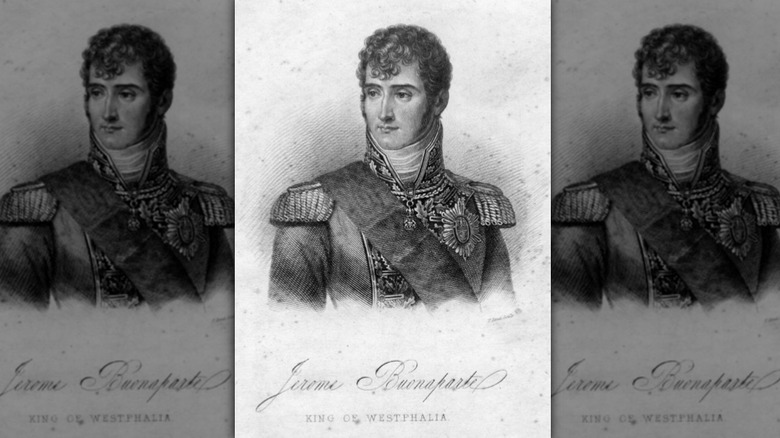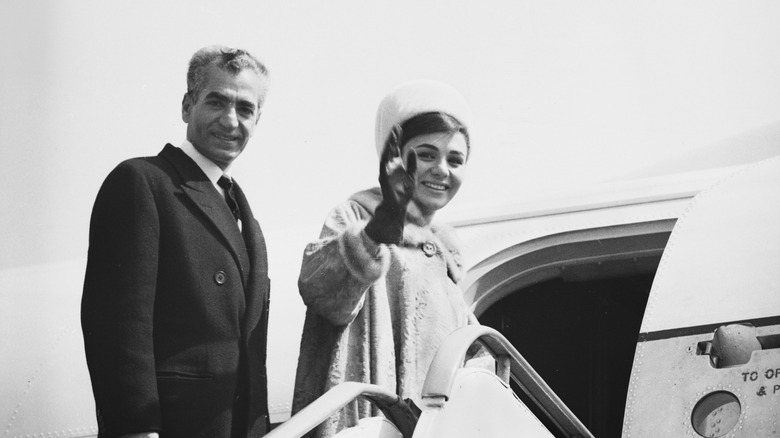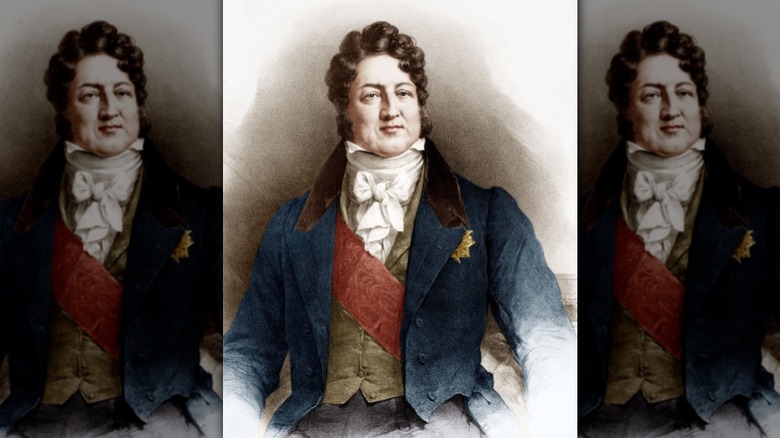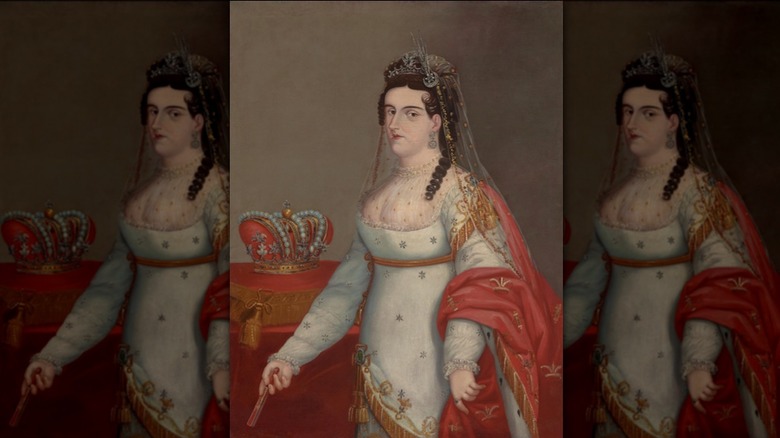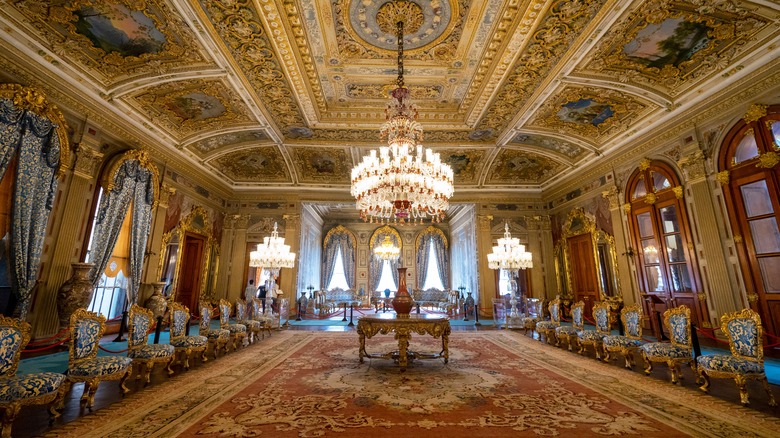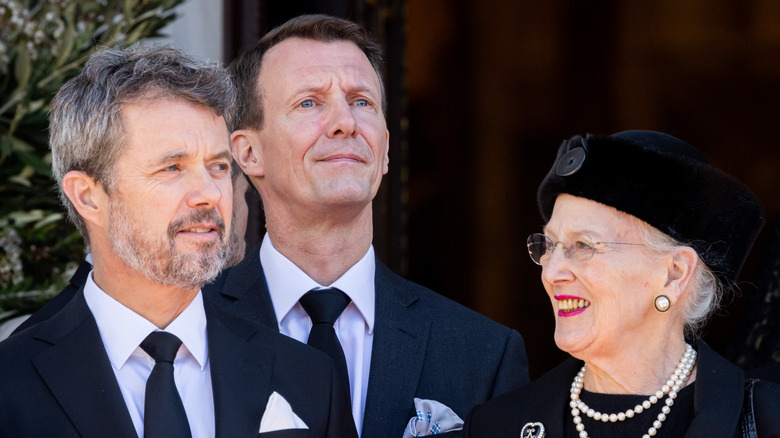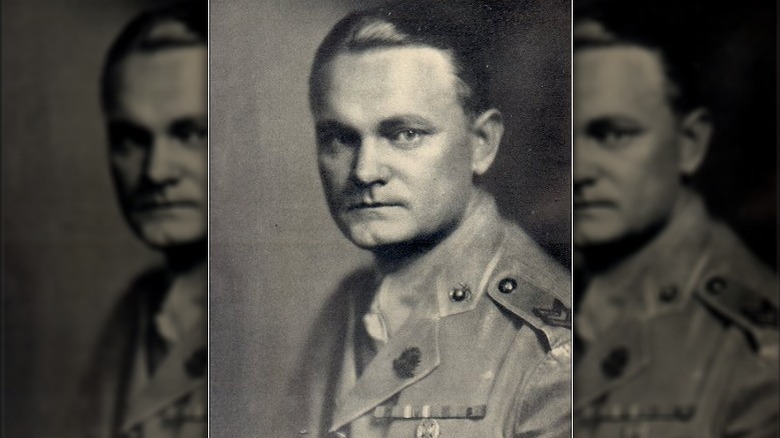Royals Who Left Their Countries To Move To America
On the basis of the nation's founding alone, Americans might not seem to be fans of monarchy. After all, the country fought a war to free itself from the rule of the world's most prominent royal family in Great Britain. But despite its republican (small "r") leanings, the United States has always held an allure for royals either fleeing their political opponents, taking sojourns, or simply looking for a good time. In fact, long before Edward VIII of England met Wallis Simpson and abdicated the throne, he had fallen in love with American culture on various visits starting in 1919.
Edward was by no means the first European royal to look for love across the pond either. Several French royals did the same thing as early as 1796. For other royals, life in America has come as a result of exile or, in many cases, to simply pursue the American dream; more than one former European royal has found economic success in the United States. Then, there are those who are in conflict with their families and want to elope. Here are some royals who decided (or were forced) to ditch their old lives to try and make it in the United States of America.
Jerome Bonaparte
Jérôme Bonaparte played second fiddle to his more famous brother Napoleon, who among many of the lesser-known weird things he did, dictated Jérôme's personal life. But initially, Jérôme made his own fate, leaving France at 20 to marry wealthy 18-year-old Baltimore socialite Elizabeth Patterson in 1803. The couple seemed over the moon and Elizabeth quickly became pregnant with their son. Napoleon, however, wasn't having any of it. He ordered his brother to return to France and annul his marriage, even barring Elizabeth from French-controlled Europe. Despite Jérôme's pleas, he relented after Napoleon threatened to take away his titles. There was just one problem: the pope refused to grant an annulment.
In the end, Napoleon declared the marriage null by his own authority and married Jérôme off to German princess Catharina von Württemberg. But Jérôme still loved Elizabeth, who had given birth to their U.S. citizen son Jérôme Napoleon Bonaparte in 1805. So what was the hard-partying but ultimately unhappy elder Jérôme to do? He offered Elizabeth land and titles in Westphalia, giving her the chance to be the "other" woman. She, however, would not accept anything less than being his wife and queen of Westphalia. That could not materialize, so she returned to Baltimore.
Together, Elizabeth and Jérôme end up siring the little-known American Bonapartes. Jérôme Napoleon Bonaparte II attended West Point and served with distinction in the French army before settling in Washington, D.C. Jérôme Napoleon's grandson went to Harvard and served as Teddy Roosevelt's attorney general, ensuring that American Bonapartes did not disappear into obscurity. Not bad for spurned royalty.
Andrew Romanov
The grandnephew of Tsar Nicholas II, Andrew Romanov's parents were members of the Russian imperial family who survived the bloody 1917 Bolshevik Revolution by fleeing to Britain. His great-uncle the tsar and his family were not so lucky, being gunned down and bayoneted by Bolsheviks in one of the many messed-up things that happened during the Russian Revolution. Andrew was born in exile in 1923, and appears to have never set foot in his ancestral homeland. Among the many fascinating facts about England's Windsor Castle is that Andrew spent an insular childhood there, followed by military service in the British Navy and work as a farmhand. Andrew then decided to try his luck in the United States. He left Britain in 1949, settled in San Francisco, and became a naturalized citizen in 1956, having renounced his title in the process as required by immigration law.
In America, Andrew completely eschewed royal life in favor of the hip. He was in the middle of the counterculture in the 1960s and '70s in San Francisco and later Marin County, where he worked as a jeweler and carpenter. His neighbors all loved him for his modesty and simple living, something unexpected for a member of an illustrious house such as the Romanov family. Yet, they noted that he still maintained a certain poise and dignity befitting of his station that made him seem regal.
Andrew Romanov died in November 2021 and was given a Russian Orthodox funeral, dying as an ordinary American citizen who had kept his ancestral culture, language, and family in the private sphere in return for the American dream.
Joel Makonnen of Ethiopia
In 1974, the Soviet-backed communist Derg overthrew the last Ethiopian Emperor Haile Selassie, ending the dynasty that had ruled the country since 1274 and traced its ancestry back to the biblical King Solomon and the Queen of Sheba. However, Selassie's relatives survived, fleeing the communists for exile in Europe and eventually, the United States. Today, the heir to the Ethiopian throne is Joel Makonnen, who told Business Insider his own story of how he came to the United States. Makonnen was born in exile in Rome and is the great-grandson of Haile Selassie. However, unlike the Windsors, who generally have flaunted their royal lineage, Makonnen said he rarely, if ever, discussed it. So when he met his wife, the American Ariana Austin (pictured with Makonnen) at a Washington, D.C. nightclub, she was in for a shock.
Austin found out about her then-boyfriend's lineage when a mutual friend spilled Makonnen's secret. It didn't prove to be much of an impediment, however, since the two eventually married in a lavish Ethiopian Orthodox wedding, albeit one that was modified to ensure the bride's father could walk her down the aisle. Within the United States, however, they do not use their royal titles.
The couple founded a media company called Old World // New World, which seeks to tell the stories of Africa and its diaspora through television and film. Makonnen still retains some financial interest in his family's home country, being the co-owner of the Wabe Shebelle Hotel S.C in Addis Ababa, Ethiopia's capital city.
Mohammad Reza Pahlavi and family
The last shah of Iran left his homeland in 1979, after the nation's Islamic Revolution toppled the pro-American monarch in favor of Ayatollah Ruhollah Khomeini's Islamic Republic of Iran. The shah and his family became wanderers, eventually settling in the United States.
Mohammad Reza Pahlavi never quite found a home outside his native Iran. The United States had offered him asylum in Florida, with Khomeini's blessing. The shah seemed willing to accept the offer, but he remained in Egypt and Morocco for a while, hoping that the situation in Iran would calm down and give him a way to return. However, the situation in Iran worsened with the Iranian hostage crisis, to the point where admitting the shah to the U.S. might be potentially dangerous to the lives of American citizens. Nevertheless, thanks to lobbying by Carter administration heavyweights David Rockefeller and Henry Kissinger, President Jimmy Carter eventually let the shah in for medical treatment in late 1979.
The shah eventually moved on and died in Egypt in 1980. His son, Crown Prince Reza, however, remains in the United States to this day, and is an activist for a secular, democratic Iran. Reza has not rejected the possibility of retaking his father's throne, perhaps as a constitutional monarch. He has, however, made it absolutely clear that he will only do so if the Iranian people want him and his family back. Otherwise, he is happy to be a focal point for resistance against the Islamic Republic, whose overthrow he advocates.
Dimitri Karadjordjevic of Yugoslavia
Boasting a handful of illustrious ancestors from around Europe, Prince Dimitri is the son of Prince Alexander of Yugoslavia and Italian princess Maria Pia di Savoia. Growing up surrounded by the jewelry of numerous European royal families, including the famous Romanov treasure, the prince developed a love of precious stones that led him to leave his native France for New York City to pursue his dream. The prince initially moved to New York in 1983 to work on Wall Street with the firm EF Hutton. He soon left that world to pursue his passion for gems, working at various auction houses and jewelers before launching his own eponymous business in 1999.
The prince's jewelry pieces are informed by another of his great loves, history, and he chooses his materials and designs straight out of the history books. One example is the Savoy knot, historically considered a symbol of true and enduring love, which adorns many of Dimitri's pieces. Another of his favorite materials is Damascus steel, said to be the Latin crusaders' favored material for making their weapons.
Today, the prince's company produces jewelry lines catering to people from the uber-rich to the upper-middle class. And given that his pieces have been modeled in the biggest fashion houses, it is safe to say that his American gamble paid off in style.
Louis Philippe d'Orleans
Louis Philippe d'Orléans was a member of the House of Orleans — a cadet branch of the Bourbon dynasty — who would eventually become king of France. Long before that, he was a proponent of the French Revolution, although he turned against the uprising after it came for his cousin King Louis XVI and then his own father.
The duke left France and sailed across the ocean to the young republic of the United States of America. After an unsuccessful courtship of Philadelphia socialite Abby Willing, he and his two brothers decided to take a trip south, first to Baltimore and then to Washington, D.C. (at the time little more than a swamp). Then they made an impromptu and unannounced stop at Mount Vernon, home to none other than George Washington. The former president entertained the duke, who announced that he wanted to explore the natural beauty of the United States. The ever-generous Washington responded by tracing an itinerary in red ink on the duke's map, a souvenir that the duke would later show off. Not everyone could brag about having a personal note from the first president.
The journey took them from Mount Vernon through Tennessee, Pennsylvania, New York State, and finally to Boston. Along the way, the brothers experienced American egalitarianism at its finest after they were thrown out of an inn because one of the duke's brothers did not want to eat with the crowd. After four years in the United States, they returned to Europe. Louis-Philippe would have to wait 30 more years, but he eventually got his throne.
Ana Maria Huarte of Mexico
Emperor Agustín Iturbide was Mexico's first monarch, reigning over a vast empire that stretched from Oregon to Panama for one year from 1822 to 1823. However, he was forced to abdicate and was eventually executed by republican forces led by a name that Americans might be more familiar with: Antonio Lopez de Santa Anna.
Iturbide's wife, Ana María Huarte, was a problem for the new Mexican government, which did not know what to do with her. Fearing that she or her children might try to retake Iturbide's throne, she was exiled abroad to the United States. In June of 1825, the former Mexican empress and her family arrived in Baltimore. Part of the condition of her exile was that the Mexican government would provide her a pension, which initially allowed the former empress to live comfortably at 226 Spruce Street in Philadelphia. But the rest of her life would be spent fighting for the payments and avoiding insolvency, especially once Mexico stopped paying due to the Mexican-American War of 1846-48.
As the war was ending, the former empress sought none other than President James Polk's help to get her money. He wrote that, through an interpreter, the empress asked him to make Mexico pay for her pension as part of the treaty, with money that U.S. troops had taken from Mexico to support their occupation. It is unclear what the result of the meeting was, but it does not appear to have mattered. The empress died in 1861, apparently in a poor financial state. She was buried in the cemetery of her parish, St. John's Catholic Church in Philadelphia.
Bayezid Osmanoglu
The Ottoman Empire officially ended in 1922, after its defeat and partition by the Entente Powers in World War I. But the extended imperial family was not exiled. Many stayed in Istanbul's Dolambahce Palace (above) until 1924, when a new regime forced them out. In 1923, Mustafa Kemal Atatürk consolidated power and transformed Turkey into a republic. The following year, among Atatürk's first actions was to expel the remaining Ottoman imperial family from Istanbul to France on a mere 24 hours' notice. Prince Bayezid Osmanoğlu was inside his mother's womb at the time.
Bayezid was the first Ottoman royal to enter the world in exile, and there would be no charity to support the previously luxurious lifestyle that many of them had been accustomed to. Thus, Bayezid made his own way in the world as his relatives took working-class jobs, from chauffeuring to pressing clothes. Things improved for Bayezit when his divorced mother married American millionaire William Daus. After World War II broke out, the family moved to New York City, where Bayezid's future as an American was sealed. He first served in the U.S. Army and then worked for the city's famous Public Library, where his fluency in six languages made him the perfect candidate for taking care of the foreign books section.
Bayezit died in 2017, aged 92, a humble librarian who had worked for virtually everything he had. With his death, the last speaker of the high palace dialect of Ottoman Turkish passed, and an era drew to a close.
Prince Joachim of Denmark
In 2022, Prince Joachim of Denmark (pictured center) was in the Danish news after his mother and then-queen, Margrethe II, stripped his children of all their royal titles, allegedly on a mere five days' notice. The official reason was to allow Joachim and his children to live more normal lives, although the real reason was more to reduce the size of the royal family and therefore its expenditures.
Nonetheless, Joachim continues to serve the Danish state in a military capacity – a path that brought him and his family to the United States in September 2023. As a defense attaché at the Danish embassy in Washington, D.C., the prince's job is a sort of liaison between the Danish government and military on one hand and the U.S. military and defense industry on the other. While royals are often given cushy sinecures, this posting has the not-inconsiderable task of promoting transatlantic military cooperation between the United States, Canada, Denmark, and the rest of Europe.
Denmark has been a NATO member since 1949, and the timing and purpose of the prince's move to the United States may have been related to Russia's 2022 invasion of Ukraine. Although the prince did not provide any more specifics about the position, it came at a time when the governments of Europe and North America were cooperating on responses to the conflict.
Faustin Wirkus
This story is a bit different, in that it involves a bizarre incident during the American occupation of Haiti between 1915 and 1934. Sources disagree on exact years for the following events, but we do know that Faustin Wirkus, a young Polish-born marine, was shipped out to Haiti in the early years of the occupation. There, he seems to have saved a woman who styled herself "Queen Timemenne of La Gonave" from a vicious beating at the hands of a tax collector.
Eventually, he was stationed at Timemenne's home on the Haitian island of La Gonâve, where he received a royal welcome. "Queen" Timemenne declared him King Faustin Wirkus of La Gonâve and her co-ruler. He lived in a concrete house and worked as a doctor, midwife, and ruler for several years, becoming a much-loved figure among the islanders.
Eventually, Wirkus was ordered back to Port-au-Prince, bringing his "reign" to an end, and in 1931 he completed his service and received a discharge. According to Wirkus' own book, "The White King of La Gonave," Timemenne told him to go do his duty to his superiors and country, but to never forget his "children" on La Gonâve and to return if he ever had the chance. She gave him a "great motherly hug" and he went on his way, returning to the United States to write his memoirs.
Prince Harry
In possibly one of the most famous examples of what happens when royals marry commoners, the relationship between Britain's Prince Harry, Duke of Sussex, and his family, the Windsors, has long been strained, largely thanks to the fallout from events that occurred after his marriage to American socialite Meghan Markle.
In an interview with James Corden, the prince — who simply went by his first name and paid his bus fare for one of LA's double-deckers — mentioned having settled in Santa Barbara. During the interview, Harry noted that the problems between him and his relatives were made considerably worse by the media printing stories that he said were either not true or grossly exaggerated. He added that when Queen Elizabeth II — who was one of the longest-reigning monarchs in history — was alive, she still sent her grandchildren presents and ensured that they were taken care of as family members. That was a very different angle from the stories alleging that there had been a fallout over Meghan's race, which came up in an interview with Oprah Winfrey.
The couple moved into a multi-million-dollar mansion in Montecito, California, and have retained the title of Duke and Duchess of Sussex. It remains to be seen if Prince Harry will fully mend fences with his family: Although he did attend his father King Charles III's coronation in 2023, and in May 2025 expressed a desire for reconciliation, Harry has also firmly ruled out moving his family back to the U.K.

